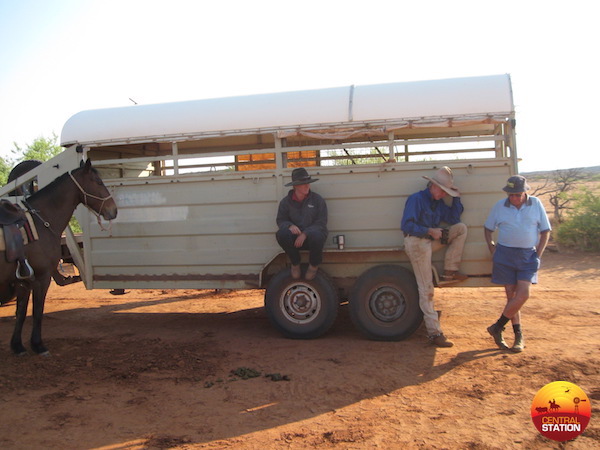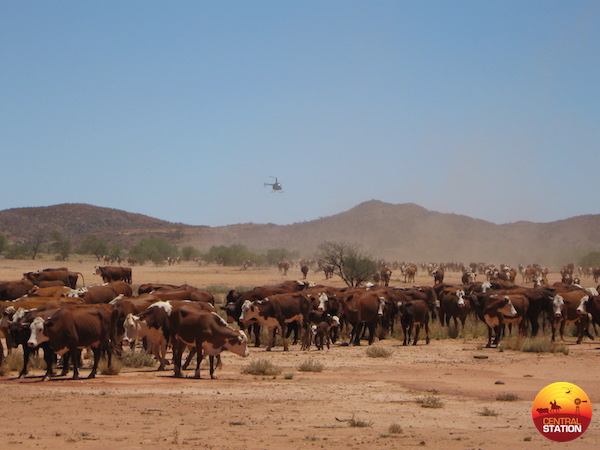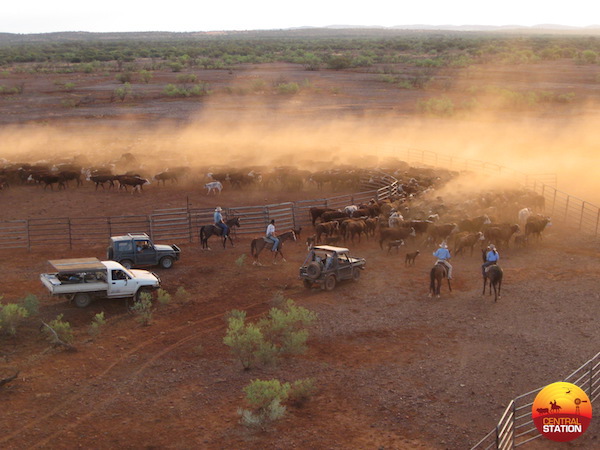Coacher Mustering
Host: Horsemanship Linked Learning
Written by Shorna Ross
During the years I worked at Ashburton we ‘Coacher Mustered’ and this is what I would like to talk about today. There was very little fencing on the place, only a few small paddocks to stockpile sale cattle in between export boats. Therefore the majority of the station was open range and we mustered accordingly. Basically this involved mustering by areas related to where the cattle watered. We would go out and set up panel yards ready to muster into, drop a few 44 gallon drums of Av Gas in a strategically planned place for the Chopper and charge UHF radios. Before daylight, around 3.30 am, someone, usually me, would crawl out of bed to give the horses brekky and to start the generator. The generator starting would get a bit of life happening around the homestead and we would have brekky ourselves and get things like smokos, lunches, and water bottles ready for the day. We would then load the horses into the gooseneck under the lights of the shed and head off just as the sun was starting to come up in a dusty convoy, horse riders squashed into the ute, and buggy drivers revving along in their little Suzuki’s with homemade bar work.
 Some of our crew playing Hurry Up and Wait.
Some of our crew playing Hurry Up and Wait.
Once we got out to our starting point we watched the sunrise and played what I used to jokingly call “Hurry Up and Wait”. Some mornings the boss would draw a bit of a map in the dirt for the chopper pilot, they would have a chat and then would start their real work for the day. They would fly out of our sight and sound and eventually bring in the initial whack of cattle for our ‘Coacher Mob’. This could be ten minutes to a few hours depending on how the cattle were spread. We would work as a team to pull them up, gather them together, and settle them down. With young cattle and cleanskins (unbranded/unmarked beasts) who had never seen people before it was important not to spook them by galloping around, rather pay attention and work them quietly and this is where we would test our stockmanship skills for the first time during the day.
Once our ‘Coacher Mob’ was settled we would get ready to move off. This involved some organisation regarding who would ride where before we began. Generally we would have horsemen in the lead and the two points (front corners) and either buggy drivers or horsemen on the wing and tail. If we were short-handed they would cover both the wings and tail. My favourite place to ride was on the point. As we moved off the cheekiest beasts would end up making their way to the lead and try to break out and it was the point and lead riders job to keep watch and turn them straight back into the mob. If you paid attention and watched them working their way through this was quick, simple and easy. If you were dreaming and left it even a fraction of a second too late they would break away and often the mob would need pulling up again while the breakaway was dealt with which chewed up time and ultimately money by using more chopper hours and stressing cattle out.
 Chopper Pilot Victor Gleeson bringing cattle into our ‘Coacher Mob’ at Lightning Flat.
Chopper Pilot Victor Gleeson bringing cattle into our ‘Coacher Mob’ at Lightning Flat.
As the day progressed we would continue walking our ‘Coacher Mob’ and pull up from time to time to receive cattle from the chopper in strategically planned places. Open flats were the best but sometimes not all that available and it could often get interesting having fresh cattle join us while we were in scrubby or rough areas with very little room for error. The aim was to have these fresh cattle come in at a place where we could get a handle on them and as quickly and easily as possible, settle them into our mob then continue our way onto our final destination and yard up. Throughout the day a chief aim was to keep cattle walking at a consistent pace to allow for the youngest and weakest beasts to keep up comfortably. We strived to ensure cows and calves stayed mothered up and that cattle walked, not ran. I found mustering in this way the most enjoyable and to have a positive impact on cattle. Calves still had their mums, sale cattle were not stressed and held their weight, bulls and cleanskins weren’t knocked around or bruised, young cattle were ‘broken in’ quickly and efficiently to being handled and by the time we got to yard up the process went smoothly and cleanly and it was very satisfying closing the gates at the end of the day.
 Yarding up at #9 Photo credit Victor Gleeson.
Yarding up at #9 Photo credit Victor Gleeson.
